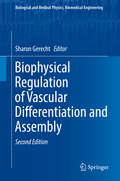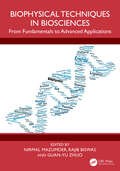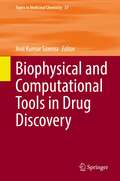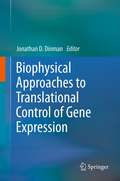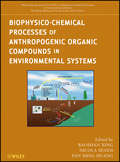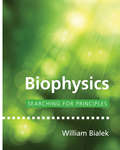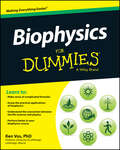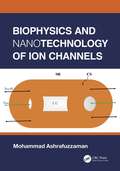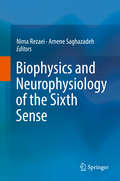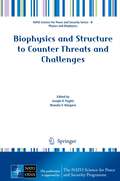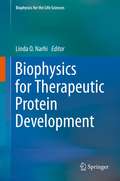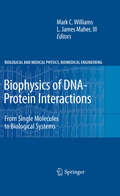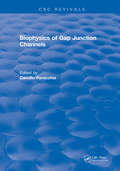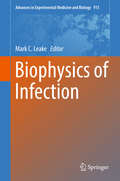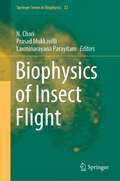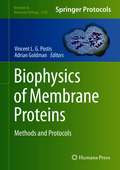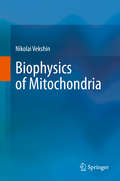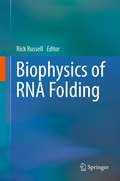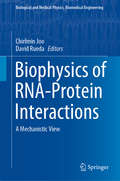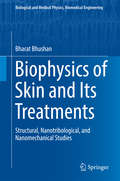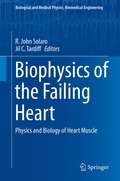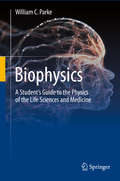- Table View
- List View
Biophysical Regulation of Vascular Differentiation and Assembly (Biological and Medical Physics, Biomedical Engineering)
by Sharon GerechtThis book updates and expands on various aspects of the vasculature’s microenvironment and how these regulate differentiation and assembly. Discussed in this new edition are efforts to capitalize on combing engineering techniques, to study and manipulate various biophysical cues, including: endothelial cell- pericyte interactions (Davis), mechanical forces to regulate vascularization in three-dimensional constructs (Levenberg), how matrix properties and oxygen tension regulate vascular fate and assembly (Gerecht), biophysical cues in relation to vascular aging (Ferreira), 3D printing of complex vascularized tissue (Hibino), the harnessing of biophysical cues for therapeutic vasculature interfacing with the damaged brain (Segura) and finally, the infarcted heart (Grayson). This second edition of Biophysical Regulation of Vascular Differentiation and Assembly provides an interdisciplinary view of vasculature regulation thru various biophysical cues and presents recent advances in measuring and controlling such parameters. This book will be of interest to biologists, biophysicists and engineers who work with vascular differentiation and assembly.
Biophysical Techniques in Biosciences: From Fundamentals to Advanced Applications
by Nirmal Mazumder, Rajib Biswas, Guan-Yu ZhuoThis book details the latest advancements in spectroscopic, analytical and imaging techniques, emphasizing their crucial roles in both research and biomedical diagnostics. The initial chapters introduce the fundamental principles of the techniques, highlighting the use of optical spectroscopies for disease diagnosis, such as oral cancer. The book also explores their innovative applications, such as quantitative optical phase imaging, and the examination of biopolymers like starch through spectroscopy and microscopy. Further, the book discusses cutting-edge developments in biomaterials essential for understanding tissue engineering and the innovative use of synthesized bioactive glasses. The chapters also examine revolutionary methods such as HPLC and HPTLC techniques for detailed analysis at unprecedented scales and for observing various processes in health and disease. Importantly, the book reviews the impact of machine learning in enhancing the accuracy of disease diagnoses through nonlinear optical microscopy. The book also presents technological breakthroughs in the transformative impact of these techniques in developing diagnostic and therapeutic solutions. This book is intended for students, researchers, and professionals in biophysics, medical imaging, and biomedical engineering.Key Features: Highlights innovative applications such as quantitative optical phase imaging and the use of spectroscopy in disease diagnosis Explores the fundamental principles of advanced spectroscopic and imaging techniques Demonstrates the role of new technologies like synthesized biomaterials and applications of HPLC techniques Discusses the integration of machine learning with nonlinear optical microscopy to enhance the accuracy of disease diagnoses Presents the latest developments in biomaterials that are revolutionizing tissue engineering
Biophysical and Computational Tools in Drug Discovery (Topics in Medicinal Chemistry #37)
by Anil Kumar SaxenaThis book reviews recent physicochemical and biophysical techniques applied in drug discovery research, and it outlines the latest advances in computational drug design. Divided into 10 chapters, the book discusses about the role of structural biology in drug discovery, and offers useful application cases of several biophysical and computational methods, including time-resolved fluorometry (TRF) with Förster resonance energy transfer (FRET), X-Ray crystallography, nuclear magnetic resonance spectroscopy, mass spectroscopy, generative machine learning for inverse molecular design, quantum mechanics/molecular mechanics (QM/MM,ONIOM) and quantum molecular dynamics (QMT) methods. Particular attention is given to computational search techniques applied to peptide vaccines using novel mathematical descriptors and structure and ligand-based virtual screening techniques in drug discovery research. Given its scope, the book is a valuable resource for students, researchers and professionals from pharmaceutical industry interested in drug design and discovery.
Biophysical approaches to translational control of gene expression (Biophysics for the Life Sciences #1)
by Jonathan D. DinmanThis book provides a premier resource on understanding the ribosome's essential nature and how it interacts with other proteins and nucleic acids to control protein synthesis. As one of the central foundations in our understanding of the biology at the molecular level, this topic appeals to a wide audience, from bench researcher to clinician. With the advent of atomic scale structures, methods to visualize and separate individual molecules, and the computational power to model the complex interactions of over a million atoms at once, our understanding of how gene expression is controlled at the level of protein translation is now deeply ensconced in the biophysical realm.
Biophysico-Chemical Processes of Anthropogenic Organic Compounds in Environmental Systems
by Baoshan Xing Nicola Senesi Pan Ming HuangIn contrast to the classical books which largely focus on separate, individual physicochemical and biological aspects, this book aims to integrate the frontiers of knowledge on the fundamentals and the impact of physicochemical and biological interactions and processes of AOCs in soil, sediment, water and air. The specific objectives of this book are to address: (1) fundamental biophysico-chemical processes of AOCs in the environment, (2) occurrence and distribution of AOCs in air, water, and soil, and their global cycling, (3) the state-of-the-art analytical techniques of AOCs, and (4) restoration of natural environments contaminated by AOCs. The book also identifies the gaps in knowledge on the subject matter and as such provides future directions to stimulate scientific research to advance the chemical science on biophysico-chemical interfacial reactions in natural habitats. By virtue of complex nature of the interactions of AOCs with different environmental components and matrixes, no single available technique and instrument is satisfactory yet for determining their fate, transport, availability, and risk in the environment. In order to fully understand the biophysico-chemical interactions and processes of AOCs in the environment, it is critical to know chemical, physical and biological properties of AOCs and their analytical techniques. The book is unique because of its multidisciplinary approach as it provides a comprehensive and integrated coverage of biophysico-chemical reactions and processes of AOCs in various environments, associated analytical techniques, and restoration of natural environments contaminated by AOCs.
Biophysics
by Patrick F. DillonSpecifically tailored to life science students, this textbook explains quantitative aspects of human biophysics with examples drawn from contemporary physiology, genetics and nanobiology. It outlines important physical ideas, equations and examples at the heart of contemporary physiology, along with the organization necessary to understand that knowledge. The wide range of biophysical topics covered include energetics, bond formation and dissociation, diffusion and directed transport, muscle and connective tissue physics, fluid flow, membrane structure, electrical properties and transport, pharmacokinetics and system dynamics and stability. Enabling students to understand the uses of quantitation in modern biology, equations are presented in the context of their application, rather than derivation. They are each directed toward the understanding of a biological principle, with a particular emphasis on human biology. Supplementary resources, including a range of test questions, are available at www.cambridge.org/9781107001442.
Biophysics
by William BialekInteractions between the fields of physics and biology reach back over a century, and some of the most significant developments in biology--from the discovery of DNA's structure to imaging of the human brain--have involved collaboration across this disciplinary boundary. For a new generation of physicists, the phenomena of life pose exciting challenges to physics itself, and biophysics has emerged as an important subfield of this discipline. Here, William Bialek provides the first graduate-level introduction to biophysics aimed at physics students. Bialek begins by exploring how photon counting in vision offers important lessons about the opportunities for quantitative, physics-style experiments on diverse biological phenomena. He draws from these lessons three general physical principles--the importance of noise, the need to understand the extraordinary performance of living systems without appealing to finely tuned parameters, and the critical role of the representation and flow of information in the business of life. Bialek then applies these principles to a broad range of phenomena, including the control of gene expression, perception and memory, protein folding, the mechanics of the inner ear, the dynamics of biochemical reactions, and pattern formation in developing embryos. Featuring numerous problems and exercises throughout, Biophysics emphasizes the unifying power of abstract physical principles to motivate new and novel experiments on biological systems. Covers a range of biological phenomena from the physicist's perspective Features 200 problems Draws on statistical mechanics, quantum mechanics, and related mathematical concepts Includes an annotated bibliography and detailed appendixes Instructor's manual (available only to teachers)
Biophysics For Dummies
by Ken VosThe fun, easy way to get up to speed on biophysics concepts, principles, and practicesOne of the most diverse of modern scientific disciplines, biophysics applies methods and technologies from physics to the study of biological systems and phenomena, from the human nervous system to soil erosion to global warming. What are the best options for satisfying the world's growing energy demands? How can we feed the world's growing population? How can we contain, or reverse, global warming? How can we vouchsafe a plentiful supply of potable water for future generations? These are among the critical questions to which biophysicists work to provide answers.Biophysics courses are increasingly taken by students of biology, physics, chemistry, biochemistry, physiology, statistics, bioengineering, neuroscience, computer science, pharmacology, agriculture,and many moreProvides a friendly, unintimidating overview of the material covered in a typical college-level biophysics courseA one-stop reference, course supplement and exam preparation tool for university students currently enrolled in an introductory biophysics coursesAn indispensable resource for those studying the natural sciences, biological sciences, and physics, as well as math, statistics,computer science, pharmacology and many other disciplinesThe current job market for people well versed in biophysics is very strong, and biophysics is currently listed as one of the fast-growing occupations in the North America
Biophysics and Nanotechnology of Ion Channels
by Mohammad AshrafuzzamanThis book provides a comprehensive review of the biophysics and nanotechnology of ion channels. It details the biological and physiological entities of ion channels in cells and addresses various physical perspectives of ion channel structures and functions. Naturally inbuilt and artificial applicable nanotechnologies of ion channels are modelled and explored. It discusses various methods that can be utilized toward understanding ion channel-based cellular diseases. Physical, biochemical, biomedical, and bioinformatics techniques are taken into consideration to enable the development of strategies to address therapeutic drug discovery and delivery. This book will be of interest to advanced undergraduate and graduate students in biophysics and related biomedical sciences in addition to researchers in the field and industry. Features: Provides a stimulating introduction to the structures and functions of ion channels of biological cell membranes and discusses the biophysics of ion channels in condensed matter state and physiological condition Addresses natural processes and nanotechnology opportunities for their purposeful manipulation Lays the groundwork for vitally important medical advances Mohammad Ashrafuzzaman, a biophysicist and condensed matter scientist, is passionate about investigating biological and biochemical processes utilizing the principles and techniques of physics. He is an associate professor at King Saud University’s Biochemistry Department of College of Science, Riyadh, Saudi Arabia, the co-founder of MDT Canada Inc., and the founder of Child Life Development Institute, Edmonton, Canada. He also authored Nanoscale Biophysics of the Cell and Membrane Biophysics.
Biophysics and Neurophysiology of the Sixth Sense
by Nima Rezaei Amene SaghazadehMultiple senses, like multiple intelligences, are a key to brain variability and therefore human evolution. Besides the traditional five senses (vision, olfaction, gustation, audition, and somatosensory), humans can also perceive the body's own position (the sense of proprioception) and movement (the vestibular sense). Interoception is the feeling one has about the internal physiological conditions of the entire body. Additionally there is a sense of intuition, also known as the sixth sense. Despite their best efforts, researchers are still unable to concur in specifying the nature of the sixth sense; some consider the sense of proprioception as the sixth sense, whereas others prefer to consider that as a part of interoception. This book will provide a scientific system for the human sixth sense using relevant biophysical and neurophysiological evidence.
Biophysics and Structure to Counter Threats and Challenges (NATO Science for Peace and Security Series B: Physics and Biophysics)
by Manolia V. Margaris Joseph D. PuglisiThis ASI brought together a diverse group of experts who span virology, biology, biophysics, chemistry, physics and engineering. Prominent lecturers representing world renowned scientists from nine (9) different countries, and students from around the world representing eighteen (18) countries, participated in the ASI organized by Professors Joseph Puglisi (Stanford University, USA) and Alexander Arseniev (Moscow, RU). The central hypothesis underlying this ASI was that interdisciplinary research, merging principles of physics, chemistry and biology, can drive new discovery in detecting and fighting chemical and bioterrorism agents, lead to cleaner environments and improved energy sources, and help propel development in NATO partner countries. At the end of the ASI students had an appreciation of how to apply each technique to their own particular research problem and to demonstrate that multifaceted approaches and new technologies are needed to solve the biological challenges of our time. The course succeeded in training a new generation of biologists and chemists who will probe the molecular basis for life and disease.
Biophysics for Therapeutic Protein Development (Biophysics for the Life Sciences #4)
by Linda O. NarhiThis book can be used to provide insight into this important application of biophysics for those who are planning a career in protein therapeutic development, and for those outside this area who are interested in understanding it better. The initial chapters describe the underlying theory, and strengths and weaknesses of the different techniques commonly used during therapeutic development. The majority of the chapters discuss the applications of these techniques, including case studies, across the product lifecycle from early discovery, where the focus is on identifying targets, and screening for potential drug product candidates, through expression and purification, large scale production, formulation development, lot-to-lot comparability studies, and commercial support including investigations.
Biophysics of DNA
by Alexander VologodskiiSurveying the last sixty years of research, this book describes the physical properties of DNA in the context of its biological functioning. It is designed to enable both students and researchers of molecular biology, biochemistry and physics to better understand the biophysics of DNA, addressing key questions and facilitating further research. The chapters integrate theoretical and experimental approaches, emphasising throughout the importance of a quantitative knowledge of physical properties in building and analysing models of DNA functioning. For example, the book shows how the relationship between DNA mechanical properties and the sequence specificity of DNA-protein binding can be analyzed quantitatively by using our current knowledge of the physical and structural properties of DNA. Theoretical models and experimental methods in the field are critically considered to enable the reader to engage effectively with the current scientific literature on the physical properties of DNA.
Biophysics of DNA-Protein Interactions: From Single Molecules to Biological Systems (Biological and Medical Physics, Biomedical Engineering)
by L. James Maher III Mark C. WilliamsDepite the rapid expansion of the field of biophysics, there are very few books that comprehensively treat specific topics in this area. Recently, the field of single molecule biophysics has developed very quickly, and a few books specifically treating single molecule methods are beginning to appear. However, the promise of single molecule biophysics is to contribute to the understanding of specific fields of biology using new methods. This book would focus on the specific topic of the biophysics of DNA-protein interactions, and would include the use of new approaches, including both bulk methods as well as single molecule methods. This would make the book attractive to anyone working in the general area of DNA-protein interactions, which is of course a much wider market than just single molecule biophysicists or even biophysicists. The subject of the book will be the biophysics of DNA-protein interactions, and will include new methods and results that describe the physical mechanism by which proteins interact with DNA. For example, there has been much recent work on the mechanism by which proteins search for specific binding sites on DNA. A few chapters will be devoted to experiments and theory that shed light on this important problem. We will also cover proteins that alter DNA properties to facilitate interactions important for transcription or replication. Another section of the book will cover the biophysical mechanism by which motor proteins interact with DNA. Finally, we will cover larger protein-DNA complexes, such as replication forks, recombination complexes, DNA repair interactions, and their chromatin context.
Biophysics of Gap Junction Channels
by M.D. PeracchiaThis book provides a state of the art account of present knowledge of the biophysics of cell-to-cell channels. It is divided into two sections, one dealing with two-cell systems and the other with reconstitution systems.
Biophysics of Infection (Advances in Experimental Medicine and Biology #915)
by Mark C. LeakeThis book describes modern biophysical techniques that enable us to understand and examine dynamic processes of infection at the molecular level. Cutting-edge research articles, laboratory protocols, case studies and up-to-date reviews cover topics such as single-molecule observation of DNA replication repair pathways in E. coli; evolution of drug resistance in bacteria; restriction enzymes as barriers to horizontal gene transfer in Staphylococcus aureus; infectious and bacterial pathogen biofilms; killing infectious pathogens through DNA damage; bacterial surfaces in host-pathogen interactions; bacterial gene regulation by riboswitches; transcription regulation in enterobacterial pathogens; the bacterial flagellar motor; initial surface colonization by bacteria; Salmonella Typhi host restrictions; as well as monitoring proton motive force in bacteria; microbial pathogens using digital holography; mathematical modelling of microbial pathogen motility; neutron reflectivity in studying bacterial membranes; force spectroscopy in studying infection and 4D multi-photon imaging to investigate immune responses. The focus is on the development and application of complex techniques and protocols at the interface of life sciences and physics, which increase the physiological relevance of biophysical investigations.
Biophysics of Insect Flight (Springer Series in Biophysics #22)
by N. Chari Prasad Mukkavilli Laxminarayana ParayitamThis book basically involves the study of flight parameters, wing beat frequency, moment of inertia, and wing movements for developing various aerodynamic forces which have been calculated. The book is intended for biologists, physicists, nanotechnologists, and aerospace engineers. Resilin, an elastic polymer (4 λ) which is present at the base of insect, plays a major role in Neurogenic and Myogenic insect flyers and influences the physiology of flight muscles. Leading edge vortex (LEV) is a special feature of insect flight. Insect wings have stalling angle above 60 degrees as compared to a man-made aeroplane stalling angle which is 16 degree. Reynolds number, the knowledge of LEV, and detailed study of moment of inertia help in developing flapping flexible wings for micro-aerial-vehicles. This book serves as an interface between biologists and engineers interested to develop biomimicking micro-aerial-vehicles. The contents of this book is useful to researchers and professionals alike.
Biophysics of Membrane Proteins: Methods and Protocols (Methods in Molecular Biology #2168)
by Adrian Goldman Vincent L. G. PostisThis volume provides recent advances in the field of biophysics of membrane proteins. Chapters are divided into several parts: detailing biochemistry and functional analysis, experimental and theoretical structural determinations, membrane protein dynamics, and conformation studies. Written in the highly successful Methods in Molecular Biology series format, chapters include introductions to their respective topics, lists of the necessary materials and reagents, step-by-step, readily reproducible laboratory protocols, and tips on troubleshooting and avoiding known pitfalls.Authoritative and cutting-edge, Biophysics of Membrane Proteins: Methods and Protocols aims to provide comprehensive protocols with notes to help further the understanding of key membrane protein structure and function for students, academics, and industrial researchers.
Biophysics of Mitochondria
by Nikolai VekshinIn this monograph, the author -Head researcher at the Institute of Cell Biophysics of Russian Academy of Sciences- discusses the results of his own long-term studies of mitochondria as well as alternative points of view and experiments of other important researchers in the field. The monograph contains the main aspects of mitochondrial research by a number of physical methods: fluorescence spectroscopy, UV-vis spectrophotometry, IR spectroscopy, light-scattering, optical microscopy, fluorescence microscopy, colorimetry, photobleaching, polarography, among others. The monograph is very useful for researchers and graduate students specializing in mitochondrial biophysics, biochemistry, molecular biology and cytology. The book was published in Russian in 2019 by Photon Publishers (Pushchino, Moscow region).
Biophysics of RNA Folding (Biophysics for the Life Sciences #3)
by Rick RussellThis volume, written by experts in the field, discusses the current understanding of the biophysical principles that govern RNA folding, with featured RNAs including the ribosomal RNAs, viral RNAs, and self-splicing introns. In addition to the fundamental features of RNA folding, the central experimental and computational approaches in the field are presented with an emphasis on their individual strengths and limitations, and how they can be combined to be more powerful than any method alone; these approaches include NMR, single molecule fluorescence, site-directed spin labeling, structure mapping, comparative sequence analysis, graph theory, course-grained 3D modeling, and more. This volume will be of interest to professional researchers and advanced students entering the field of RNA folding.
Biophysics of RNA-Protein Interactions: A Mechanistic View (Biological and Medical Physics, Biomedical Engineering)
by David Rueda Chirlmin JooRNA molecules play key roles in all aspects of cellular life, but to do so efficiently, they must work in synergism with proteins. This book addresses how proteins and RNA interact to carry out biological functions such as protein synthesis, regulation of gene expression, genome defense, liquid phase separation and more.The topics addressed in this volume will appeal to researchers in biophysics, biochemistry and structural biology. The book is a useful resource for anybody interested in elucidating the molecular mechanisms and discrete properties of RNA-protein complexes. Included are reviews of key systems such as microRNA and CRISPR/Cas that exemplify how RNA and proteins work together to perform their biological function. Also covered are techniques ranging from single molecule fluorescence and force spectroscopy to crystallography, cryo-EM microscopy, and kinetic modeling.
Biophysics of Skin and Its Treatments: Structural, Nanotribological, and Nanomechanical Studies (Biological and Medical Physics, Biomedical Engineering)
by Bharat BhushanThis book provides a comprehensive overview of the structural, nanotribological and nanomechanical properties of skin with and without cream treatment as a function of operating environment. The biophysics of skin as the outer layer covering human or animal body is discussed as a complex biological structure. Skin cream is used to improve skin health and create a smooth, soft, and flexible surface with moist perception by altering the surface roughness, friction, adhesion, elastic modulus, and surface charge of the skin surface.
Biophysics of the Failing Heart: Physics and Biology of Heart Muscle (Biological and Medical Physics, Biomedical Engineering)
by Jil C. Tardiff R. John SolaroSubjects in the monograph "Biophysics of the Failing Heart" include state of the art chapters considering major biophysical mechanisms for why hearts responding to acquired or inherited stressors enter into maladaptive processes eventually leading to an inability of the heart to respond efficiently to hemodynamic loads especially during exercise. The chapters describe biophysical techniques that have been applied to determine the triggers for the heart failure process as well as the mechanisms for sustaining the disorders. These techniques include measurements of active and passive mechanical properties and hemodynamics at levels of organization ranging from molecules to hearts beating in situ. Biophysical concepts and approaches are also applied to determination of signaling and signal transduction, energetics, ionic currents, transport processes, electro-chemical and chemo-mechanical coupling. By its emphasis on biophysical aspects of a prevalent clinical condition, the monograph is unique in its perspective and focus. The breadth of information in the chapters all in one place will be of value to clinicians and researchers at all levels. Modern research approaches and clinical understanding of heart failure demands integration of multiple aspects of the disorders. In most cases, combinations of clinician scientists and researchers author the chapters. A main benefit of the book is couched in its didactic approach together with its emphasis on how biophysical concepts and techniques aid in diagnosis and development of new therapies.
Biophysics: A Student’s Guide to the Physics of the Life Sciences and Medicine
by William C. ParkeThis comprehensive and extensively classroom-tested biophysics textbook is a complete introduction to the physical principles underlying biological processes and their applications to the life sciences and medicine. The foundations of natural processes are placed on a firm footing before showing how their consequences can be explored in a wide range of biosystems. The goal is to develop the readers’ intuition, understanding, and facility for creative analysis that are frequently required to grapple with problems involving complex living organisms. Topics cover all scales, encompassing the application of statics, fluid dynamics, acoustics, electromagnetism, light, radiation physics, thermodynamics, statistical physics, quantum biophysics, and theories of information, ordering, and evolutionary optimization to biological processes and bio-relevant technological implementations. Sound modeling principles are emphasized throughout, placing all the concepts within a rigorous framework. With numerous worked examples and exercises to test and enhance the reader’s understanding, this book can be used as a textbook for physics graduate students and as a supplementary text for a range of premedical, biomedical, and biophysics courses at the undergraduate and graduate levels. It will also be a useful reference for biologists, physicists, medical researchers, and medical device engineers who want to work from first principles.
Biophysics: An Introduction (Springer Series In Biophysics Ser. #5)
by Roland GlaserBiophysics is the science of physical principles underlying all processes of life, including the dynamics and kinetics of biological systems.This fully revised 2nd English edition is an introductory text that spans all steps of biological organization, from the molecular, to the organism level, as well as influences of environmental factors. In response to the enormous progress recently made, especially in theoretical and molecular biophysics, the author has updated the text, integrating new results and developments concerning protein folding and dynamics, molecular aspects of membrane assembly and transport, noise-enhanced processes, and photo-biophysics. The advances made in theoretical biology in the last decade call for a fully new conception of the corresponding sections. Thus, the book provides the background needed for fundamental training in biophysics and, in addition, offers a great deal of advanced biophysical knowledge.
